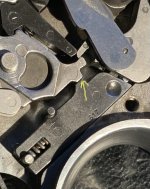scooter123
Member
You need a new Sear spring, something that should be available at Brownells.
I'll also note that to remove the Sear from the hammer requires using very thin tools such as two Exacto Knife blades to compress the spring into it's guide hole in the hammer. Walk it down 1 coil at a time until it's all the way down, hold it down and the sear will slide right out.
I just checked Brownell's and Midwest Gun Works. The Sear Spring is common to all recent (1950 & later) revolvers, ie. the J, K, L, N, and X frames. Apparently Brownell's isn't as interested in stocking repair parts as they once were, because while it's in the schematic Brownell's no longer carries this part. Midwest Gun Works lists it and it's currently out of stock. Good news is that it is IN STOCK at Numrich Gun Parts and cost is only $ 2.80. See the following link and scroll down to item 50.
Smith & Wesson 10-1 Revolver Parts, Schematics | Numrich Gun Parts
I'll also note that to remove the Sear from the hammer requires using very thin tools such as two Exacto Knife blades to compress the spring into it's guide hole in the hammer. Walk it down 1 coil at a time until it's all the way down, hold it down and the sear will slide right out.
I just checked Brownell's and Midwest Gun Works. The Sear Spring is common to all recent (1950 & later) revolvers, ie. the J, K, L, N, and X frames. Apparently Brownell's isn't as interested in stocking repair parts as they once were, because while it's in the schematic Brownell's no longer carries this part. Midwest Gun Works lists it and it's currently out of stock. Good news is that it is IN STOCK at Numrich Gun Parts and cost is only $ 2.80. See the following link and scroll down to item 50.
Smith & Wesson 10-1 Revolver Parts, Schematics | Numrich Gun Parts
Last edited:


